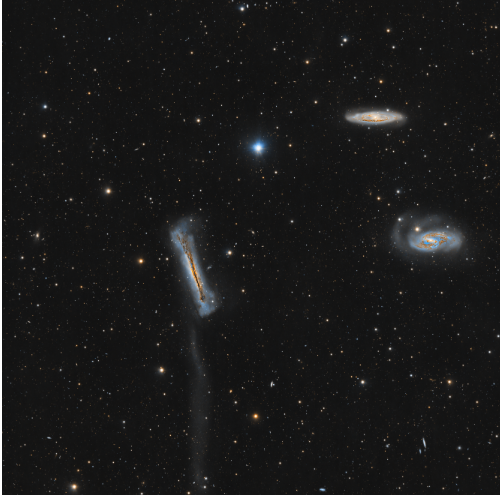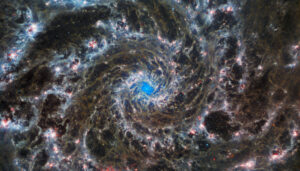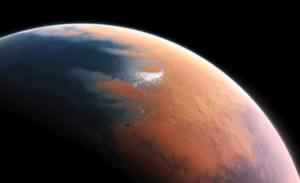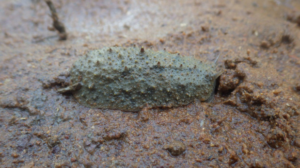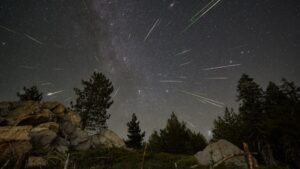THE CASUAL OBSERVER
May continues the season of Djeran – the season where the cooler weather begins.
The perfect night to go outside this month is May 4, also known as Star Wars Day (May the Fourth be with you).
On this date, start your night sky observations by looking to the north-northwest where you will see three pairs of interesting things – Mars and the Moon, as well as the constellations of Gemini and Canis Minor, both identified by two easy-to-see stars.
Caption: The northern evening sky on May 4.
Credit: Stellarium
The First Quarter Moon is the brightest object by far, and nearby is the fainter, red Mars. Scientists have recently proposed a new model for why Mars is red.
Instead of hematite (a ‘dry’ kind of iron rust) scientists have found evidence of ferrihydrite, a ‘wet’ iron rust that has water locked up in its molecular structure. This is more evidence suggesting that Mars once had great oceans on its surface.
To the lower left of Mars is the red giant star Pollux, in Gemini. Pollux has a twin, called Castor, but they couldn’t be more different.The single, enormous, red giant star Pollux is nothing like the six-stars-in-one system that we see as the single ‘star’ Castor.
If you time your observations right, at exactly 7:13 pm on May 4 you’ll see a bright light moving across the northwestern sky. Passing between Castor and Pollux, it will slide under the Moon before fading out of sight in the northern sky. That’s no Moon, it’s a space station. Specifically, the International Space Station.
Caption: Instantaneous location of the International Space Station (blue box) at 7:13:44 pm on May 4
Finally, Canis Minor shines with the bright star Procyon and the fainter Gomeisa. These make up the body of the Small Dog in the sky and the companion to Canis Major.
Caption: Yeah, looks like a dog to me.
Credit: Stellarium
Next to this spectacular sextuple is the constellation of Leo, the lion. A zodiacal constellation, Leo is one of the few constellations that actually kind of looks like what it is supposed to represent.
Caption: Leo, the lion, in stick figure. Moon and Mars for reference on May 4.
Credit: Stellarium
After you’ve taken in these night sky delights, you can either go to bed early or stay up all night. Either way, the Eta Aquarids meteor shower puts on a show before sunrise on May 5.
Caption: Apparent location of the sky of the Eta Aquarids meteor shower at 5am on May 5. Venus and Saturn guide the way.
This vibrant meteor shower has bright streaks that originate from the illustrious Halley’s Comet. As Halley’s Comet moves through our Solar System on its approximately 75-year orbit, it occasionally passes close enough to the Sun to get hot enough for some of its fragile material to boil away into space. This ‘outgassing’ carries lots of dirt and pebbles with it which are left free floating in space. Eventually, some of these pieces of dirt collide with Earth and light up our sky as they slam into the atmosphere, causing a meteor shower.
The Eta Aquarids meteor shower is not to be missed. In good conditions you should see a meteor every minute or two. These meteors move fast across the sky, and the shower actually lasts all month. The best way to see it is to look to the east before sunrise on May 5 or 6.If you forget to set the alarm on these days, you can try again throughout the month of May.
While you are watching the meteor shower, you can’t not-see Venus. Fabulously bright and dominating the eastern morning sky, it makes for wonderful viewing as it glows against the twilight of sunrise.
At Scitech we get a lot of phone calls and emails asking about ‘the big bright thing in the sky’ during the early morning or evening, depending on the time of year. It “seems to be following me.” It’s “there every morning. Almost white it’s so bright.” These are all sightings of Venus. It takes its name for the goddess of love, so named because it burns so bright.
This also reminds me, I need to set my automatic replies:
Caption: Sorted.
ISS sightings from Perth
The International Space Station passes overhead multiple times a day. Most of these passes are too faint to see but a couple of notable sightings* are:
| Date, time | Appears | Max Height | Disappears | Magnitude | Duration |
| 2 May 7:10 PM | 10° above SW | 82° | 82° above NW | -3.8 | 3 min |
| 3 May 6:21 PM | 10° above SW | 49° | 12° above ENE | -3.5 | 6 min |
| 4 May 7:10 PM | 10° above WSW | 22° | 10° N | -1.3 | 5 min |
Source: Heavens above, Spot the Station
*Note: These predictions are only accurate a few days in advance. Check the sources linked for more precise predictions on the day of your observations.
If you are wondering why the station disappears in the middle of the sky on May 2, read our article here.
Moon phases
May 4: First Quarter
May 13: Full Moon
May 20: Last Quarter
May 27: New Moon
Dates of interest
May 4: Star Wars Day, Moon near Mars. May 5: Eta Aquarids meteor shower peaks before sunrise
May 6: Eta Aquarids meteor shower peaks before sunrise
May 23: Moon near Saturn and Venus
Planets to look for
Mars makes for decent viewing in the north-northwest this month. You can see it next to the Moon on May 4 as described above.
Jupiter is visible for an hour or so after sunset in the northwest. Catch it this month before it disappears behind the Sun. It will reappear in the eastern sky before sunrise in early July.
Caption: Mars and Jupiter in the northwestern evening sky on May 4.
Credit: Stellarium
Venus and Saturn are visible in the eastern sky before sunrise. Venus dominates the scene while the fainter Saturn hangs a bit higher in the sky above it. Mercury is also there, closer to the horizon, but it moves behind the Sun in the latter part of the month and gets lost in the glare.
Venus and Saturn separate noticeably in the sky this month. Interestingly, this is the opposite of what it looks like. It appears that Saturn is racing higher in the sky, and Venus is standing still, almost hovering above the horizon. What’s really happening is Earth’s movement around the Sun makes Saturn appear to move quite a lot. Not to be outdone, Venus moves even faster, effectively ‘cancelling out’ the movement of Earth and making it appear to hang in the same place. This is much more obvious if you look at the background stars and compare where Saturn and Venus are against them.
Credit: Leon Smith/Scitech, Stellarium.
Constellation of the month
Leo – The Lion
Leo is a large constellation visible in the northern sky during Autumn. It is a very distinctive constellation whose stars form an upside down question mark sitting next to a triangle and are collectively seen as a lion.
Caption: Leo, the Lion, with the question mark (left) and triangle (right) easily discernible.
In mythology, Leo is often seen as the Nemean Lion associated with the story of Heracles (Hercules) and his twelve labours. The first labour of Hercules was to kill the lion, a task made infinitely more difficult by the fact that the lion’s hide could not be pierced by weaponry, rendering swords and spears useless. Problem solving on the spot, Heracles strangled the lion with his bare hands, whereupon Zeus placed it in the sky as Leo.
The brightest star in Leo is the magnitude 1.35 Regulus, meaning ‘little king’. This 4-star system consists of two pairs of stars orbiting each other and is the namesake of Regulus Black from the Harry Potter stories. One could argue that the star is better described by its Arabic name Qalb al-Asad, meaning ‘the heart of the lion’.
Leo also includes the Cosmic Horseshoe. This happens when you have one very distant background galaxy on almost exactly the same line of sight as a foreground galaxy.
Caption: The Cosmic Horseshoe.
Credit: NASA, ESA
Einstein’s general relativity predicts that the gravity of a massive object – like a galaxy – should bend the path of light as it passes by. In this case, the reddish galaxy in the foreground (excitingly named LRG 3-757) has enough gravity to act like the lens of a magnifying glass, focussing the light from the background galaxy in a process called gravitational lensing. A slight misalignment from an exact line of sight leaves a small gap at the top, giving the horseshoe appearance. A perfectly circular lensed galaxy is called an Einstein Ring. The effect allows us to peer around the foreground galaxy to see what is behind it, albeit in a very distorted view.
Caption: Schematic diagram of gravitational lensing. Imagine this happening on every side of the massive object and you can see how a ring of light is formed.
Credit: NASA
Leo is also home to the Leo Cluster – a group of about 70 galaxies bound together by gravity located about 300 million lightyears away.
Caption: The Leo Cluster of galaxies and many more distant background galaxies. Apart from two stars, marked by horizontal lines, every other point of light is a galaxy.
Credit: By Legacy Surveys / D.Lang (Perimeter Institute) & Meli thev – Own work, CC BY-SA 4.0
Together with the Coma Cluster – a collection of about 1000 galaxies located in the neighbouring constellation of Coma Berenices – they form part of a larger cluster of galaxies called the Coma Supercluster. This is part of an even larger cluster of galaxies called the Great Wall. Astronomers group clusters of galaxies together based on their proximity and motion through space to better understand the large-scale structure of the Universe and how it got to be the way that it is today.
Object for the small telescope
The Leo Triplet – A cosmic trio of galaxies far, far away
The Leo Triplet is a throuple of galaxies close together in both line of sight and real-life proximity. Consisting of the Hamburger Galaxy (yes, seriously) and the Messier objects M65 and M66, the Leo trio are all located about 35 million lightyears away.
Caption: The Leo Triplet with M65 and M66 (top right and middle right) and the Hamburger Galaxy (middle left). It does kind of look like a hamburger.
Credit: Chuck Ayoub – Own work, CC0
A long time ago, a close encounter between M66 and the Hamburger Galaxy severely distorted both of them. The huge, bright streak trailing behind the Hamburger Galaxy, called a tidal tail, consists of material pulled from the galaxy by the gravity of M66.
Meanwhile, M66 shows obviously distorted spiral arms with more dusty material in them and an unusual distribution of gas compared to other galaxies. A great target for the keen stargazer.



